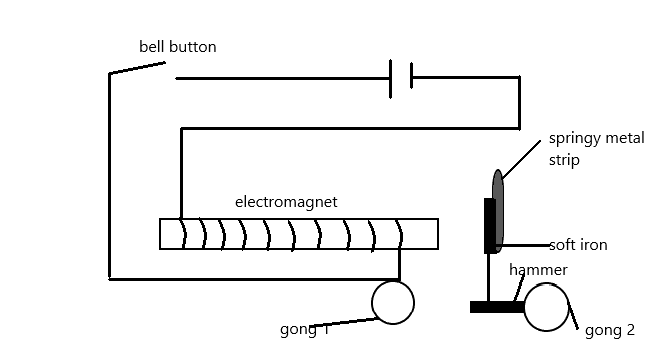
The diagram shows the circuit of a doorbell. What happens when the bell button is switched on and switched off?

Switch on Switch off A 1 ting is heard Silence B 1 ting is heard 1 ting is heard C Continuous ringing Silence D Silence Continuous ringing

| Switch on | Switch off | |
| A | 1 ting is heard | Silence |
| B | 1 ting is heard | 1 ting is heard |
| C | Continuous ringing | Silence |
| D | Silence | Continuous ringing |
Answer
450.9k+ views
Hint: When current flows through the coil of the electromagnet, it becomes attracted to the soft iron. When the current stops flowing, its attractiveness stops.
Complete step by step answer:
In the above diagram, we see the circuit diagram of a bell, which is in an off position. The bell and its circuit composed of a cell, a switch, an electromagnet, a metal strip (usually attached to a spring), a soft iron, a hammer, and a gong 1 and 2.
The working operation of the electric bell above is simple, and it goes as follows.
When the switch of the bell is closed, which is the button a person presses to ring the bell, current starts to flow through to the electromagnet. Then the electromagnet becomes attractive to the soft iron right in front of it, which moves towards the electromagnet. While doing this the hammer attached to the lower end of the soft iron collides with the gong, and a sound is heard. The soft iron remains there until the switch is released. Then electromagnet stop attracting the iron, and the soft iron returns to its initial position due to its springy metal strip. The hammer striking the second gong in the process. Hence, for one simple press and release, two sounds are heard, “ding dong”.
Hence, at switch-on, one sound is heard, and at switch off, another is heard.
Hence, the correct option is B.
Note: For clarity, the electromagnet is just a coil of wire which runs around some metal within it. This coil must be insulated so the current does not get to the metal itself. If that happens, the metal stops acting as a magnet but as a conductor.
Complete step by step answer:
In the above diagram, we see the circuit diagram of a bell, which is in an off position. The bell and its circuit composed of a cell, a switch, an electromagnet, a metal strip (usually attached to a spring), a soft iron, a hammer, and a gong 1 and 2.
The working operation of the electric bell above is simple, and it goes as follows.
When the switch of the bell is closed, which is the button a person presses to ring the bell, current starts to flow through to the electromagnet. Then the electromagnet becomes attractive to the soft iron right in front of it, which moves towards the electromagnet. While doing this the hammer attached to the lower end of the soft iron collides with the gong, and a sound is heard. The soft iron remains there until the switch is released. Then electromagnet stop attracting the iron, and the soft iron returns to its initial position due to its springy metal strip. The hammer striking the second gong in the process. Hence, for one simple press and release, two sounds are heard, “ding dong”.
Hence, at switch-on, one sound is heard, and at switch off, another is heard.
Hence, the correct option is B.
Note: For clarity, the electromagnet is just a coil of wire which runs around some metal within it. This coil must be insulated so the current does not get to the metal itself. If that happens, the metal stops acting as a magnet but as a conductor.
Recently Updated Pages
Master Class 11 Accountancy: Engaging Questions & Answers for Success

Glucose when reduced with HI and red Phosphorus gives class 11 chemistry CBSE

The highest possible oxidation states of Uranium and class 11 chemistry CBSE

Find the value of x if the mode of the following data class 11 maths CBSE

Which of the following can be used in the Friedel Crafts class 11 chemistry CBSE

A sphere of mass 40 kg is attracted by a second sphere class 11 physics CBSE

Trending doubts
10 examples of friction in our daily life

Difference Between Prokaryotic Cells and Eukaryotic Cells

State and prove Bernoullis theorem class 11 physics CBSE

What organs are located on the left side of your body class 11 biology CBSE

Define least count of vernier callipers How do you class 11 physics CBSE

The combining capacity of an element is known as i class 11 chemistry CBSE




